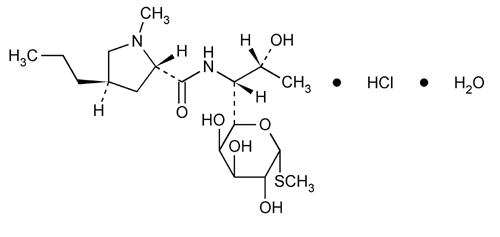Lincomycin Hydrochloride
d-erythro-
Methyl 6,8-dideoxy-6-(1-methyl-trans-4-propyl-l-2-pyrrolidinecarboxamido)-1-thio-d-erythro-
Anhydrous 443.01
» Lincomycin Hydrochloride has a potency equivalent to not less than 790 µg of lincomycin (C18H34N2O6S) per mg.
Packaging and storage—
Preserve in tight containers.
Labeling—
Where it is intended for use in preparing injectable dosage forms, the label states that it is sterile or must be subjected to further processing during the preparation of injectable dosage forms.
Identification, Infrared Absorption  197M
197M .
.
Crystallinity  695
695 :
meets the requirements.
:
meets the requirements.
pH  791
791 :
between 3.0 and 5.5, in a solution (1 in 10).
:
between 3.0 and 5.5, in a solution (1 in 10).
Water, Method I  921
921 :
between 3.0% and 6.0%.
:
between 3.0% and 6.0%.
Limit of lincomycin B—
Use the chromatogram obtained from the Assay preparation in the Assay: the area of the lincomycin B peak is not greater than 5.0% of the sum of the areas of the lincomycin B peak and the lincomycin peak.
Other requirements—
Where the label states that Lincomycin Hydrochloride is sterile, it meets the requirements for Sterility and Bacterial endotoxins under Lincomycin Injection. Where the label states that Lincomycin Hydrochloride must be subjected to further processing during the preparation of injectable dosage forms, it meets the requirements for Bacterial endotoxins under Lincomycin Injection.
Assay—
Mobile phase—
Add 13.5 mL of phosphoric acid to 1000 mL of water, and adjust with ammonium hydroxide to a pH of 6.0. Prepare a filtered and degassed mixture of this solution, acetonitrile, and methanol (780:150:150). Make adjustments if necessary (see System Suitability under Chromatography  621
621 ).
).
Standard preparation—
Dissolve an accurately weighed quantity of USP Lincomycin Hydrochloride RS in Mobile phase to obtain a solution having a known concentration of about 1.2 mg per mL, using sonication if necessary to effect solution.
Assay preparation—
To about 12 mg of Lincomycin Hydrochloride, accurately weighed, add 10.0 mL of Mobile phase. Shake by mechanical means for 5 minutes, and sonicate if necessary to effect solution.
Chromatographic system
(see Chromatography  621
621 )—The liquid chromatograph is equipped with a 210-nm detector and a 4.6-mm × 25-cm column that contains 5-µm packing L7 and is maintained at a temperature of 46
)—The liquid chromatograph is equipped with a 210-nm detector and a 4.6-mm × 25-cm column that contains 5-µm packing L7 and is maintained at a temperature of 46 . The flow rate is about 1 mL per minute. Chromatograph the Standard preparation, and record the responses as directed for Procedure: the tailing factor for the main lincomycin peak is not more than 1.3; the column efficiency determined from the main lincomycin peak is not less than 4000 theoretical plates; and the relative standard deviation for replicate injections is not more than 2.0%.
. The flow rate is about 1 mL per minute. Chromatograph the Standard preparation, and record the responses as directed for Procedure: the tailing factor for the main lincomycin peak is not more than 1.3; the column efficiency determined from the main lincomycin peak is not less than 4000 theoretical plates; and the relative standard deviation for replicate injections is not more than 2.0%.
Procedure—
Separately inject equal volumes (about 20 µL) of the Standard preparation and the Assay preparation into the chromatograph, record the chromatograms, and measure the areas for the major peaks. The relative retention times are about 0.5 for lincomycin B and 1.0 for lincomycin. Calculate the quantity, in µg, of lincomycin (C18H34N2O6S) in each mg of the Lincomycin Hydrochloride taken by the formula:
10(CP / W)(rU / rS)
in which C is the concentration, in mg per mL, of USP Lincomycin Hydrochloride RS in the Standard preparation; P is the designated potency, in µg of lincomycin per mg, of USP Lincomycin Hydrochloride RS; W is the weight, in mg, of the portion of Lincomycin Hydrochloride taken to prepare the Assay preparation; and rU and rS are the lincomycin peak responses obtained from the Assay preparation and the Standard preparation, respectively.
Auxiliary Information—
Please check for your question in the FAQs before contacting USP.
Chromatographic Column—
| Topic/Question | Contact | Expert Committee |
| Monograph | Ahalya Wise, M.S.
Scientist 1-301-816-8161 |
(MDANT05) Monograph Development-Antibiotics |
| Reference Standards | Lili Wang, Technical Services Scientist 1-301-816-8129 RSTech@usp.org |
USP32–NF27 Page 2786
Chromatographic columns text is not derived from, and not part of, USP 32 or NF 27.
